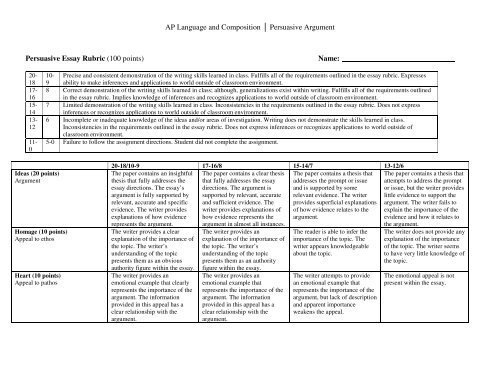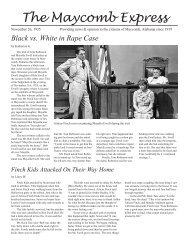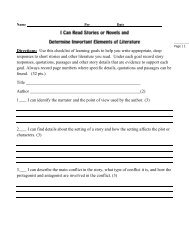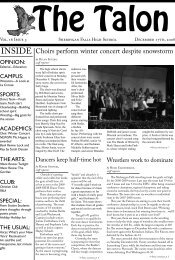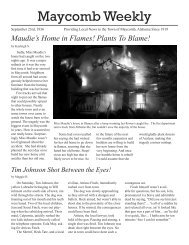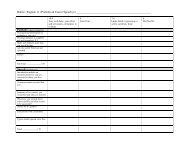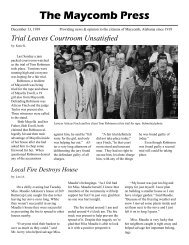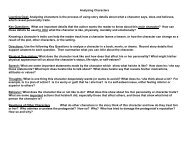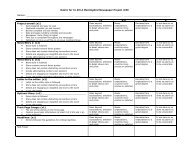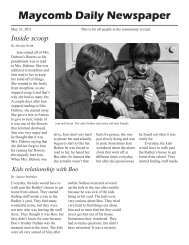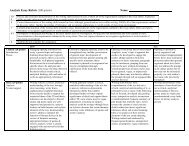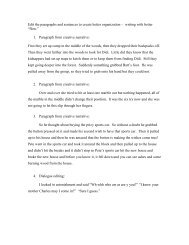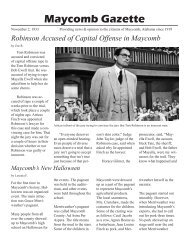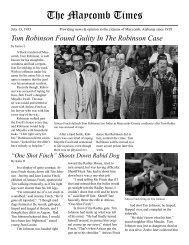Persuasive Essay Rubric
Persuasive Essay Rubric
Persuasive Essay Rubric
Create successful ePaper yourself
Turn your PDF publications into a flip-book with our unique Google optimized e-Paper software.
AP Language and Composition │ <strong>Persuasive</strong> Argument<br />
<strong>Persuasive</strong> <strong>Essay</strong> <strong>Rubric</strong> (100 points) Name:<br />
11-<br />
0<br />
20-<br />
18<br />
17-<br />
16<br />
15-<br />
14<br />
13-<br />
12<br />
10- Precise and consistent demonstration of the writing skills learned in class. Fulfills all of the requirements outlined in the essay rubric. Expresses<br />
9 ability to make inferences and applications to world outside of classroom environment.<br />
8 Correct demonstration of the writing skills learned in class; although, generalizations exist within writing. Fulfills all of the requirements outlined<br />
in the essay rubric. Implies knowledge of inferences and recognizes applications to world outside of classroom environment.<br />
7 Limited demonstration of the writing skills learned in class. Inconsistencies in the requirements outlined in the essay rubric. Does not express<br />
inferences or recognizes applications to world outside of classroom environment.<br />
6 Incomplete or inadequate knowledge of the ideas and/or areas of investigation. Writing does not demonstrate the skills learned in class.<br />
Inconsistencies in the requirements outlined in the essay rubric. Does not express inferences or recognizes applications to world outside of<br />
classroom environment.<br />
5-0 Failure to follow the assignment directions. Student did not complete the assignment.<br />
Ideas (20 points)<br />
Argument<br />
Homage (10 points)<br />
Appeal to ethos<br />
Heart (10 points)<br />
Appeal to pathos<br />
20-18/10-9 17-16/8 15-14/7 13-12/6<br />
The paper contains an insightful The paper contains a clear thesis The paper contains a thesis that<br />
thesis that fully addresses the that fully addresses the essay addresses the prompt or issue<br />
essay directions. The essay’s directions. The argument is and is supported by some<br />
argument is fully supported by supported by relevant, accurate relevant evidence. The writer<br />
relevant, accurate and specific and sufficient evidence. The provides superficial explanations<br />
evidence. The writer provides writer provides explanations of of how evidence relates to the<br />
explanations of how evidence how evidence represents the argument.<br />
represents the argument. argument in almost all instances.<br />
The writer provides a clear<br />
explanation of the importance of<br />
the topic. The writer’s<br />
understanding of the topic<br />
presents them as an obvious<br />
authority figure within the essay.<br />
The writer provides an<br />
emotional example that clearly<br />
represents the importance of the<br />
argument. The information<br />
provided in this appeal has a<br />
clear relationship with the<br />
argument.<br />
The writer provides an<br />
explanation of the importance of<br />
the topic. The writer’s<br />
understanding of the topic<br />
presents them as an authority<br />
figure within the essay.<br />
The writer provides an<br />
emotional example that<br />
represents the importance of the<br />
argument. The information<br />
provided in this appeal has a<br />
clear relationship with the<br />
argument.<br />
The reader is able to infer the<br />
importance of the topic. The<br />
writer appears knowledgeable<br />
about the topic.<br />
The writer attempts to provide<br />
an emotional example that<br />
represents the importance of the<br />
argument, but lack of description<br />
and apparent importance<br />
weakens the appeal.<br />
The paper contains a thesis that<br />
attempts to address the prompt<br />
or issue, but the writer provides<br />
little evidence to support the<br />
argument. The writer fails to<br />
explain the importance of the<br />
evidence and how it relates to<br />
the argument.<br />
The writer does not provide any<br />
explanation of the importance<br />
of the topic. The writer seems<br />
to have very little knowledge of<br />
the topic.<br />
The emotional appeal is not<br />
present within the essay.
AP Language and Composition │ <strong>Persuasive</strong> Argument<br />
Head (10 points)<br />
Appeal to logic<br />
Hand (10 points)<br />
Applies opinion to the social<br />
context of the issue<br />
Voice (20 points)<br />
Audience<br />
Authenticity<br />
Organization and publication (10<br />
points)<br />
The writer provides factual<br />
evidence that clearly supports<br />
the argument. The information<br />
provided in this appeal has a<br />
clear relationship with the<br />
argument.<br />
The writer encourages the reader<br />
to take some kind of action at the<br />
end of the essay. This action is<br />
directly related to the argument<br />
of the essay.<br />
Tone, voice, and point of view<br />
are always appropriate to the<br />
audience and purpose. The<br />
writer utilizes diction and<br />
sentence fluency appropriate to<br />
the various appeals throughout<br />
the essay. The language of the<br />
argument is academic in nature.<br />
The paper follows a clear and<br />
logical train of thought set by the<br />
thesis and advancement of<br />
appeals. The essay can be found<br />
in the writer’s AP Language and<br />
Composition Google folder. The<br />
title appears correctly:<br />
<strong>Persuasive</strong> <strong>Essay</strong>.<br />
The writer provides factual<br />
evidence that supports the<br />
argument. The information<br />
provided in this appeal has a<br />
clear relationship with the<br />
argument.<br />
The writer encourages the reader<br />
to take some kind of action at the<br />
end of the essay. This action<br />
infers a relationship to the<br />
argument of the essay.<br />
Tone, voice, and point of view<br />
are appropriate to the audience<br />
and purpose. The writer utilizes<br />
diction and sentence fluency<br />
appropriate to the various<br />
appeals. The language of the<br />
argument is academic in nature<br />
for most of the essay, but some<br />
casualness occurs.<br />
The paper follows a logical train<br />
of thought related to the thesis<br />
and advancement of appeals.<br />
The essay can be found in the<br />
writer’s AP Language and<br />
Composition Google folder. The<br />
title appears correctly:<br />
<strong>Persuasive</strong> <strong>Essay</strong>.<br />
The writer attempts to provide<br />
factual evidence that supports<br />
the argument, but it is minimal<br />
and it is unclear how it relates to<br />
the argument.<br />
The writer references an action<br />
seemingly related to the topic,<br />
but does not indicate how the<br />
reader can make this change.<br />
Tone, voice, and point of view<br />
are usually appropriate to the<br />
audience and purpose. Diction<br />
and sentence fluency are<br />
inconsistent with the appeals.<br />
The language of the argument is<br />
casual in nature.<br />
The paper follows a train of<br />
thought related to the thesis and<br />
advancement of appeals. The<br />
essay can be found in the<br />
writer’s AP Language and<br />
Composition Google folder. The<br />
essay contains the incorrect<br />
name.<br />
The logical appeal is not<br />
present within the essay.<br />
The writer supplies a cliché<br />
action related to the topic. This<br />
action, argument and the reader<br />
do not have apparent<br />
relationship.<br />
Tone, voice, and point of view<br />
are sometimes appropriate to<br />
the audience and purpose.<br />
Diction poorly represents the<br />
appeals. The language of the<br />
argument is casual in nature.<br />
The paper does not follow a<br />
train of thought related to the<br />
thesis and advancement of<br />
appeals. The essay was not<br />
located in the writer’s AP<br />
Language and Composition<br />
Google folder. The writer had<br />
to be told to place it there.<br />
Conventions (10 points)<br />
Proper MLA format is<br />
maintained throughout the essay.<br />
Standard English is maintained,<br />
spelling and punctuation errors<br />
are addressed.<br />
Proper MLA format is<br />
maintained throughout the essay.<br />
Standard English is maintained,<br />
spelling and punctuation errors<br />
are addressed; however,<br />
mistakes are made.<br />
MLA format is attempted, but<br />
does not follow the strict<br />
guidelines presented in the<br />
syllabus. There are many<br />
spelling and punctuation errors<br />
that create confusion for the<br />
reader.<br />
MLA format is missing.<br />
Writing contains numerous<br />
spelling and punctuation errors<br />
indicating the essay was not<br />
proofread for errors.


